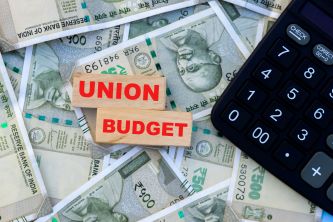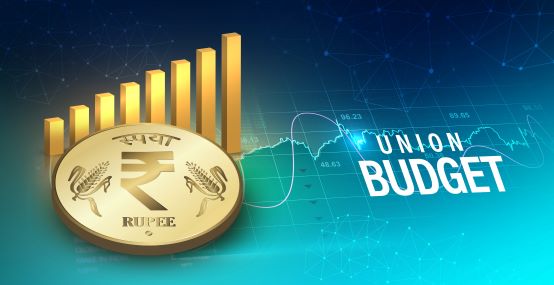What are the Components of Union Budget

Every year on the first day of February, the Finance Minister of India presents the Union Budget in the Parliament. Like a typical household budget, the Union Budget contains all components of budget information about the Government's revenues and expenditure during a given financial year.
In this article, we will tell you what Union Budget is and its components. Continue reading.
What is Union Budget?
As mentioned, the Union Budget of India is the summary of the estimated revenues and expenditure of the Government for the applicable financial year. In other words, the Union Budget keeps the account of the Government's finances for a given financial year, i.e., from 1st April to 31st March. The Union Budget is also an annual financial statement of the Government of India.
The Finance Minister of India makes a Budget speech in the Parliament every year on the 1st of February. For example, the current Finance Minister of India – Nirmala Sitharaman – would present the Union Budget 2024 on 1st February 2024.
The components of Union Budget
The Union Budget of India can be classified into two components – the revenue budget and the capital budget.
1. Revenue Budget
The revenue budget comprises the Government's financial statement of revenue receipts and expenditure for the applicable financial year. Now, what are revenue receipts and revenue expenditure?
Revenue receipts estimate the revenues the Government is expected to receive during a year. They can be from various types of taxes imposed by the Government (such as income tax, corporate tax, GST, excise duty, etc.) and non-taxable sources (such as interest, profit, fees collected for various Government services, fines, etc.)
Revenue expenditure refers to the expenses incurred by the Government for its day-to-day functioning and providing essential public services. That includes operational expenses for Government offices, salaries of Government employees, and subsidies given to the citizens, among other things.
If the revenue expenditure exceeds the revenue receipts, the Government is said to incur a revenue deficit.
2. Capital Budget
Like the revenue budget, the capital budget comprises the Government's capital receipts and payments during the applicable financial year.
Capital receipts either increase the Government's liability or reduce its financial assets. Some of the primary sources of capital receipts for the Government include:
- Loans from the public
- Loans from states and union territories
- Loans from foreign countries
- Loans from the Reserve Bank of India (RBI)
- Sale of treasury bills
- Recovery of debts
On the other hand, capital payments refer to the expenses incurred by the Government to build long-term assets and facilities for public welfare. The examples of capital payments include:
- Construction of roads, schools, hospitals, etc.
- Development and maintenance of equipment
- Development and acquisition of machinery and infrastructure
- Loans granted to states and union territories
The Structure of Union Budget
The Union Budget, or the financial statement, of India, consists of three parts:
· The consolidated fund of India (CFI)
It contains all the information regarding the government's revenues expected to receive during the applicable financial year. All Government expenses are incurred from this fund after the Parliament's authorisation.
· The contingency fund of India
The government created and maintained this fund to meet any unforeseen expenses under Article 267 of the Indian constitution. This fund can be used only after the President's assent and refills from the CFI after every use.
· Public accounts
A specific sum of money is allotted for public accounts. This money is used for various purposes, such as the construction of roads, buildings, etc. The transfer of money to public accounts from the CFI can only be done after Parliament's approval.
To conclude
The presentation of the Union Budget is a crucial annual exercise of the Government. It helps the Government carry out its constitutional duties and allocate resources in the best interest of the country. Understanding the components and structure of the Union budget is crucial as it can help you decode its implications on the country's economy and the general public.
ICICI Securities Ltd. ( I-Sec). Registered office of I-Sec is at ICICI Securities Ltd. - ICICI Venture House, Appasaheb Marathe Marg, Prabhadevi, Mumbai - 400 025, India, Tel No : 022 - 6807 7100. The contents herein above shall not be considered as an invitation or persuasion to trade or invest. I-Sec and affiliates accept no liabilities for any loss or damage of any kind arising out of any actions taken in reliance thereon. The contents herein above are solely for informational purpose and may not be used or considered as an offer document or solicitation of offer to buy or sell or subscribe for securities or other financial instruments or any other product. Investments in securities market are subject to market risks, read all the related documents carefully before investing. The contents herein mentioned are solely for informational and educational purpose.
Please Enter Email
Thank you.
Related content

Articles - Personal Finance
What is PM Gati Shakti Yojana
Hon'ble Finance Minister Nirmala Sitharaman unveiled three major economic railway corridors in the interim budget of 2024 for the PM Gati Shakti Yojana. Explore detailed information about PM Gati Shakti Yojana.

Articles - Personal Finance
Analysis of Interim Budget 2024
Get to knwo about the impact of interim budget 2024 and a detailed analysis in this article.

Articles - Personal Finance
What Is a Surplus Budget
Learn about surplus budget and how a budget surplus impacts the economony.

Articles - Personal Finance
What is a Budget Deficit
Find out the importance of budget deficit. Cause of budget deficit and What is the relationship between budget deficit and stock markets

Articles - Personal Finance
Union Budget 2024 – Trivia Part 2
The Union budget 2024 presentation is just around the corner. Let us look at some trivia regarding the Union budgets from the past

Articles - Personal Finance
What is Union Budget and Why it so Important
Learn about the what is the Union Budget in this article for a comprehensive information of its importance.

Articles - Personal Finance
Union Budget: Key Details & Importance
As we come closer to February 1, the chatter around the expectations over Union Budget increases. From young college students looking to start their careers and small business owners to leading economists and industrialists, almost every Indian citizen keeps a tab on the Budget announcement. Let us discuss what is Union Budget and its importance for the economy.

Articles - Personal Finance
Impact of the Budget 2024 on Share Markets
The Union Budget 2024 got quite a cheer from the share market as major indices ended on a positive note. The NIFTY 50 and the Sensex benchmark indices gained during the Budget speech and finished green.

Articles - Personal Finance
What to Expect From Budget 2022 for Individuals and Salaried People
Over the last two years, individuals, especially salaried people, have taken quite a hit because of the pandemic. Work from home has not only increased expenses such as electricity and WiFi bills but has also put a strain on take-home salary. Naturally, people hope that the government will step in and ease some of these troubles through their Union Budget announcements.

Articles - Personal Finance
What is the impact of the Union Budget on the Indian Stock Markets
Indian stock markets are dynamic prone to ups and downs depending on a host of factors. Every year, one major event that impacts the equities and bond markets is the announcement of the Union Budget.

Articles - Personal Finance
History of the Union Budget in India
The ritual of presenting the Indian Budget is more than two centuries old, dating back to colonial times. India's first-ever Budget was presented by James Wilson in 1860, a Scottish economist and politician.

Articles - Personal Finance
10 Taxes Affected by Budget
Taxes are the most crucial and most significant source of revenue for the Government. The Government uses the revenues generated from taxes to provide basic facilities to its citizens and the nation's overall development. For example, construction of roads, buildings, infrastructure, public healthcare facilities, providing various subsidies, etc.

Articles - Personal Finance
What is Populist Budget
A budget typically meant to please people is known as a populist budget. It spends more on lucrative schemes that can increase the Government's fiscal deficit. Such a budget doesn't have any enduring positive impact on the country's economy.

Articles - Personal Finance
Types of Budget in India
Deep dive into the three different types of government budgets and their impact on the economy.

Articles - Stocks
What is the Budget? Union Budget for Beginners
The Finance Minister of India presents the Union Budget on the first day of February every year. It is also known as the annual financial statement of the country. It contains the details of the revenue sources and expenses undertaken by the Government during the applicable financial year.

 Top Mutual Funds
Top Mutual Funds







COMMENT (0)